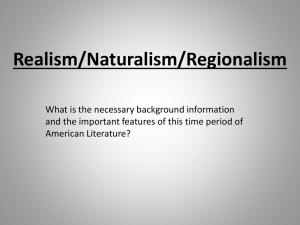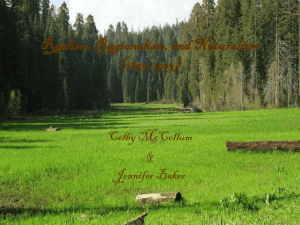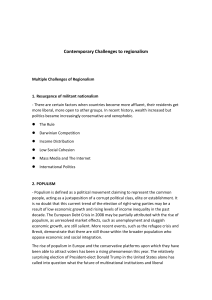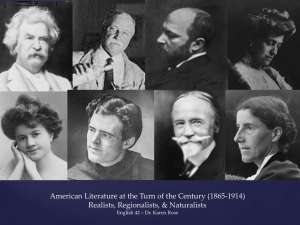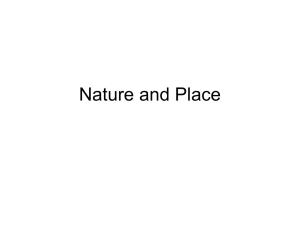The Age of Realism (1880
advertisement
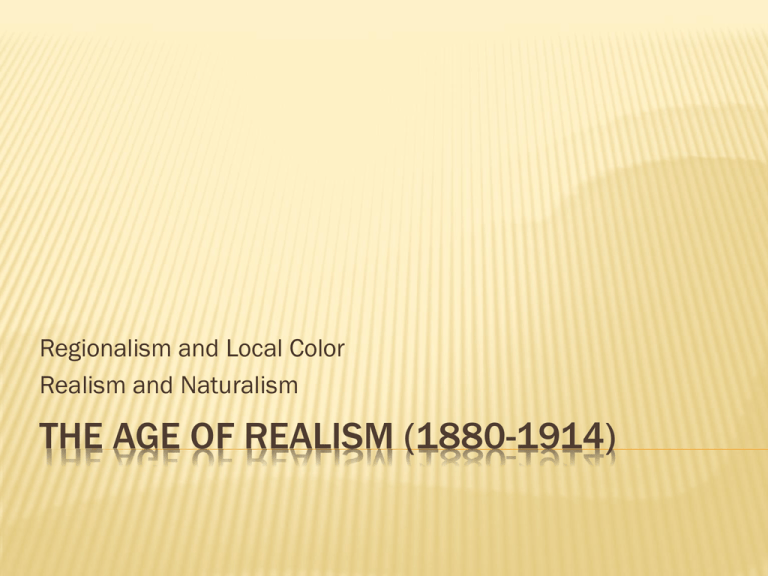
Regionalism and Local Color Realism and Naturalism THE AGE OF REALISM (1880-1914) HENRY JAMES ONCE WROTE… “What is character but the determination of incident? What is incident but the illustration of character?” POLITICAL AND SOCIAL EVENTS 1883: The Brooklyn Bridge opens 1885: The first skyscraper opens in Chicago 1893: The World’s Columbian Exposition showcases American technology and industry 1898: Spanish-American War 1903: Wright Brothers make first airplane flight 1913: Henry Ford announces the assembly line WORLD EVENTS 1881: Pasteur develops vaccine for rabies 1885: Benz produces first gasoline-operated car 1895: X-Rays discovered 1899: Aspirin is patented 1905: Einstein formulates theory of relativity 1910: Sigmund Freud publishes Psychoanalytic book 1912: The Titanic sinks 1914: World War I begins EFFECTS OF EXPANSION Population grows by 50% Endless supply of workers and resources Westward expansion Land, farms, ranches, mines Frontier declared “closed” by consensus (1890) Where to expand now? Building cities, forging industrial empires, finding distant international outposts to plant the US flag NATIVE AMERICANS US Army soldiers kill more than 200 Sioux men, women, and children Native Americans confined on reservations LITERATURE Romanticism wilted after Civil War “Realists” were a reaction to this disillusionment Focused on everyday life Ordinary human behavior “Local Color” writing reflected true-to-life… Customs Speech Character …of people in different regions of the country. PROSPERITY New inventions Airplanes, skyscrapers, motion pictures Corporations grew into monopolies Controlled wages Fixed prices Lack of competition Concentrated power in the hands of the few Gap between rich and poor became a canyon REALISTIC NOVELS Relied on emerging sciences of biology, psychology, and sociology Showed an interest in human motivation/ psychology– interior issues Realistic settings presenting adversity Battlefields, lifeboats, slums, cityscapes Realistic Authors Henry James Stephen Crane Kate Chopin REFORMS Overcrowded cities, social inequalities led to reform Roosevelt became a “trustbuster” (monopoly regulator) Labor movement Hours, working conditions, working conditions Niagara movement (W.E.B. DuBois) Female suffrage (Susan B. Anthony) Landscape and wildlife protection (John Muir) NATURALIST WRITING Relied on scientific understandings to dissect human behavior Inspired by Darwin and Freud’s recent theories Focus on environmental forces that determine human fate Jack London (Call of the Wild) Theodore Dreiser (Sister Carrie) REGIONALISM AND LOCAL COLOR Credit: Artist, Gary R. Lucy. CHARACTERISTICS OF REGIONALISM Desire to record, celebrate, and mythologize the many different and unique geographical regions Attention to recording accurately the speech, mannerisms, behavior, and beliefs of people in specific locales Local color writing “painted” the local scenes and tends toward humorous or sentimental tones MAJOR REGIONALIST AUTHORS Mark Twain Mississippi River Small river towns Bret Harte Gold-mining camps of the West Western pulp fiction Gamblers, gunfighters, gold MARK TWAIN: AUTHOR FOCUS You will understand… tall tales vernacular writer’s purpose comic devices


